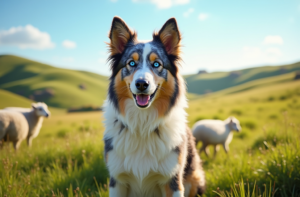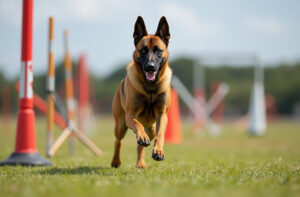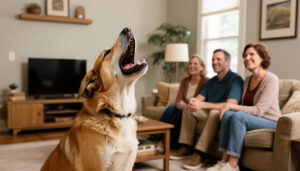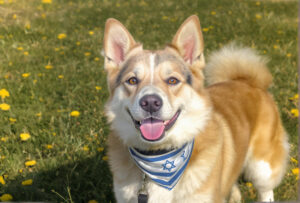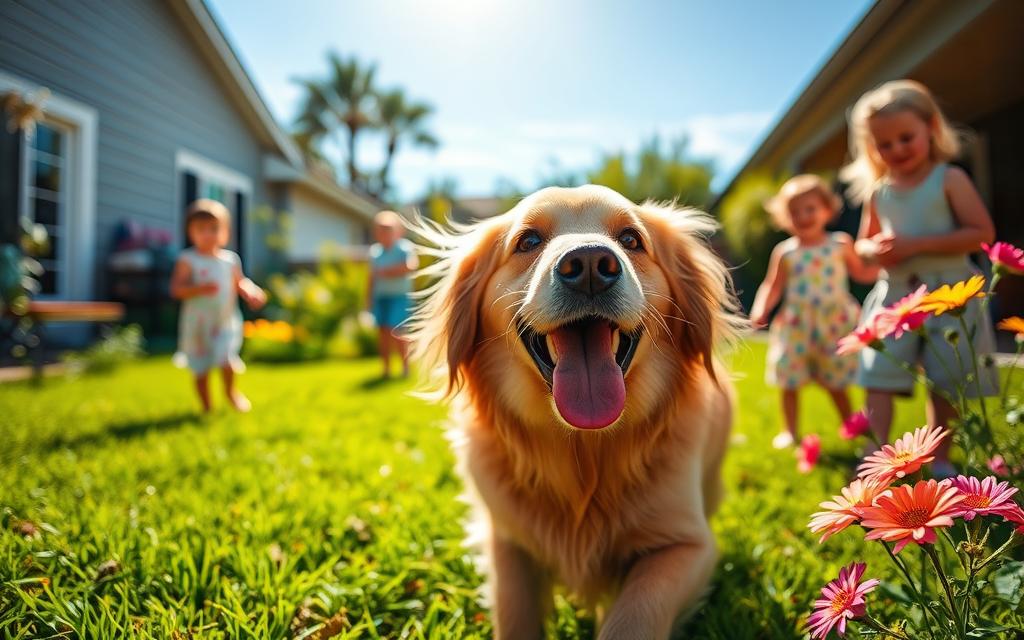
Did you know Golden Breed Dogs are the third most popular dog breed in the U.S.? They have won the hearts of millions with their smart, loyal, and loving nature. They are more than pets; they are loved family members.
These dogs are medium-sized and known for their golden coat and friendly attitude. They stand 21-24 inches tall and weigh 55-75 pounds. Their broad head, short ears, and strong build make them both beautiful and versatile.
Golden Retrievers fit well in both suburban homes and rural areas. Their adaptable and warm nature makes them perfect for families looking for a loyal and loving pet.
Key Takeaways : Golden Breed Dogs
- Ranked third most popular dog breed in the United States
- Medium-sized sporting dogs with distinctive golden coat
- Exceptional family companions with adaptable temperament
- Intelligent and loyal breed suitable for various living environments
- Known for their friendly and affectionate nature
- Understanding the Golden Breed Heritage and History
- Physical Characteristics and Breed Standards
- Golden Breed Dogs: A Perfect Family Choice
- Training and Intelligence Capabilities
- Health Considerations and Life Expectancy
- Golden breed dogs Grooming Requirements and Coat Care
- Golden breed dogs Exercise Needs and Activity Levels
- Nutrition and Dietary Guidelines
- Popular Color Variations and Coat Types
- Golden Breed Dogs Adopting vs Buying from Breeders
- Living Space Requirements and Adaptability
- Working Roles and Service Capabilities Of Golden Breed Dogs
- FAQ
Understanding the Golden Breed Heritage and History
The golden retrievers have a rich history that started in Scotland in the mid-19th century. They were created by Sir Dudley Marjoribanks, a dog lover. He worked hard to make these smart dogs.
Marjoribanks started his breeding program at Guisachan, his Scottish estate. He was born in 1820 and began recording his work early on. This left a lasting record of his dog breeding.
Scottish Roots and Early Development
Important moments in the golden retrievers’ history include:
- Discovery of a yellow-colored wavy-coated dog named Nous in 1865
- Crossbreeding with a Tweed Water Spaniel named Belle
- Creation of the first recognized golden retriever litter in 1868
Breeding Innovations
Marjoribanks chose dogs with certain traits for his breeding. He used Flat-coated Retrievers, Tweed Water Spaniels, and possibly Red Setters. His goal was to make the perfect hunting dog.
| Year | Breeding Milestone |
|---|---|
| 1865 | Acquisition of Nous |
| 1868 | First Golden Retriever Litter |
| 1881 | Marjoribanks Elevated to Baron Tweedmouth |
| 1913 | Kennel Club Official Recognition |
Global Expansion
After World War I, golden retrievers became more popular. Marjoribanks’ sons helped spread the breed. They brought two golden retrievers to North America, one to Texas and another to Canada.
Physical Characteristics and Breed Standards
Golden retrievers have a stunning golden coat that makes them stand out. They are powerful, medium-sized dogs with grace and strength. They show a perfect mix of athletic build and gentle nature.
The breed standards outline what makes golden retrievers unique:
- Male height: 23-24 inches at withers
- Female height: 21-22 inches at withers
- Male weight range: 65-75 pounds
- Female weight range: 55-65 pounds
They have a broad head, well-defined stop, and dark brown eyes. These eyes show intelligence and warmth. Their body is muscular with a deep chest and level back.
| Physical Attribute | Breed Standard Details |
|---|---|
| Coat Color | Any shade of gold or cream (excluding red or mahogany) |
| Bite | Perfect scissor bite (100% alignment) |
| Tail | Reaching hocks without curl at tip |
| Movement | Powerful with good drive, straight and true |
The United Kennel Club recognized golden retrievers in 1956. They set breed standards that highlight their exceptional qualities. These standards help keep the breed’s iconic look and function.
Golden Breed Dogs: A Perfect Family Choice
Golden Retrievers are top picks for families. They have a great temperament that makes them perfect for any home. Their gentle nature and ability to bond with family members make them very popular in America.
Temperament and Personality Traits
Golden Retrievers are smart, warm, and patient. They love to please their owners, making them easy to train. They also understand their family’s feelings, creating strong bonds.
- Consistently gentle and patient
- Highly intelligent and responsive
- Emotionally intuitive
- Eager to participate in family activities
Compatibility with Children
Golden Retrievers are great with kids. They are protective but also very patient. This makes them perfect playmates for children of all ages.
Social Nature with Other Pets
Golden Retrievers get along well with other pets. Early socialization helps them be friendly with animals. They fit well into families with cats, dogs, or smaller pets.
Golden Retrievers are the perfect family pets. They bring joy and love to many homes in the United States.
Training and Intelligence Capabilities
Golden retrievers are among the smartest dog breeds, ranking fourth in the world. Their intelligence makes them great friends for families and work settings. Originally bred for sports and retrieving, they quickly learn and follow commands.
Training a golden retriever is easy because they love to please. Studies show that about 95% of them learn commands fast, showing their quick learning skills.
- Understand commands in as few as five repetitions
- Possess adaptive intelligence comparable to a two-year-old human
- Excel in various roles including service, therapy, and assistance dogs
Golden retrievers are not just smart; they have special skills too. They are great in many jobs:
- Guide dogs for visually impaired individuals
- Emotional support animals
- Search and rescue operations
- Medical therapy assistance
Keeping their minds sharp is key. They need regular training, fun toys, and challenges. This keeps them happy and prevents boredom.
Health Considerations and Life Expectancy
Golden retrievers are loved by many as family pets. They have special health needs that owners must know about. Keeping them healthy is key to their happiness and well-being.
These dogs usually live between 10-12 years. They weigh between 55-75 pounds on average. Knowing about possible health issues is important for pet owners.
Common Health Challenges
Golden retrievers face several health problems that need attention:
- Hip and elbow dysplasia
- Eye conditions like pigmentary uveitis
- Progressive retinal atrophy
- Cancer types including lymphoma
- Hypothyroidism
- Skin problems such as atopic dermatitis
Preventive Care Strategies
Keeping golden retrievers healthy involves several steps:
- Regular vet visits
- Keeping them at a healthy weight
- Genetic testing
- Good nutrition
- Daily exercise
Health Screening Recommendations
Vets suggest thorough health checks to catch problems early. DNA testing can spot over 230 genetic health risks. This gives important info on your golden’s health.
With the right care, diet, and vet visits, golden retrievers can live a great life. This helps reduce the effects of common diseases and enhances their companionship.
Golden breed dogs Grooming Requirements and Coat Care
Golden retriever grooming is key to keeping your dog healthy and looking good. These dogs have a beautiful double coat that needs regular care. Knowing how to take care of their coat will keep them looking and feeling great.
The golden retriever’s coat needs a lot of attention. Their thick fur sheds a bit all year, but more during seasonal changes. Regular grooming helps control shedding and keeps their coat in top shape.
- Brush your golden retriever at least once a week
- Increase brushing frequency during heavy shedding seasons
- Use a pin brush or slicker brush for effective coat care
- Pay special attention to areas prone to matting behind ears and on hind legs
Getting a professional groomer can be a big help, especially for show-quality coats. They can manage coat health, trim nails, and meet specific grooming needs.
Bathing should happen monthly or when needed. Use a gentle, dog-specific shampoo to keep their coat’s natural oils. Don’t over-bathe, as it can harm their skin.
- Bathe your golden retriever every 4-6 weeks
- Use oatmeal and vitamin E shampoos for optimal coat health
- Thoroughly dry the coat after bathing
- Check for any skin irregularities during grooming
Don’t forget about ear cleaning, nail trimming, and dental care. Start grooming early to make your puppy comfortable with it.
Golden breed dogs Exercise Needs and Activity Levels
Golden retrievers are full of energy and love to stay active. They need regular exercise to stay healthy and happy. This helps prevent bad behavior too.
Daily Exercise Requirements
How much exercise a golden retriever needs depends on their age and energy level. Here’s a guide:
- Puppies: 5 minutes of exercise per month of age
- Adult dogs: 20-30 minutes of exercise twice daily
- Healthy adults: Minimum 90 minutes of high-quality physical activities
Recommended Physical Activities
Golden retrievers need different activities to stay healthy and happy. Some great options include:
- Walking and hiking
- Swimming
- Fetch games
- Agility training
- Off-leash play in secure areas
Mental Stimulation Needs
Golden retrievers are smart and need mental challenges too. They get bored and lose focus without them. Try these:
- Puzzle toys
- Obedience training
- Interactive games
- Scent work
Pro tip: Always talk to your vet to make a special exercise plan for your golden retriever. It should match their health and age.
Nutrition and Dietary Guidelines
Creating the right diet for a golden retriever is important. These dogs have special nutritional needs that change as they grow. It’s key to follow feeding guidelines for their health and happiness.
Golden retrievers need 2-3 cups of high-quality dog food each day. It’s important to measure their food to avoid obesity. Their diet should be rich in premium nutrients with certain characteristics.
- Meat should be the first ingredient
- Protein levels between 18-28% depending on age
- Fiber content around 2-5%
- Low-glycemic complex carbohydrates
Puppies have different needs than adult dogs. Young golden retrievers need more protein (22-28%) to grow fast. They usually switch to adult food between 12-15 months, when they reach certain developmental stages.
Vets advise against certain ingredients in dog food, like:
- Ethoxyquin
- BHA and BHT preservatives
- Propylene glycol
- Sodium nitrate/nitrite
Many golden retrievers are sensitive to corn and wheat. Grain-free foods can help with skin issues. But, they might face heart risks from taurine.
Practical tips include buying smaller food bags to keep food fresh. Divide daily portions into two meals. Always talk to a vet to create a diet plan that’s right for your golden retriever.
Popular Color Variations and Coat Types
Golden retrievers come in a wide range of colors that win the hearts of many. They show off amazing diversity in their coats, from light cream to deep gold.
The American Kennel Club lists many coat types and colors for golden retrievers. This variety makes each dog special and unique.
Standard Golden Breed Dogs Colours
- Light Cream: The palest shade, almost white
- Classic Golden: Rich, medium gold tone
- Dark Golden: Deep mahogany-like shade
- Golden Red: Warm, reddish-gold undertones
Coat Texture and Quality
Golden retrievers have a special double coat. The outer coat keeps water out, while the undercoat is soft and thick. Their coats can be straight or wavy.
| Color Variation | Genetic Influence | Rarity |
|---|---|---|
| English Cream | B Locus Gene | Uncommon |
| Dark Golden | B Locus Gene | Rare |
| Chocolate | B Locus Gene | Very Rare |
Seasonal Changes
Golden retriever coats change a lot with the seasons. Seasonal shedding happens in spring and fall. They grow thicker coats in winter and lighter ones in summer.
Golden Breed Dogs Adopting vs Buying from Breeders
Deciding on a golden retriever involves weighing adoption against buying from breeders. With over three million dogs in shelters, there are many options for a new pet.
Adopting a golden retriever has many benefits:
- Lower cost (average adoption fee: $150)
- Helping a dog in need
- Many are purebred or mixed breeds
- They can be ready for companionship right away
Buying from reputable breeders also has its perks:
- Known genetic background
- Early socialization
- Health screenings
- Predictable breed traits
When picking a breeder, look for those who do thorough health tests. About 25% of shelter dogs are purebred, but not all have health records.
| Adoption Approach | Breeder Approach |
|---|---|
| Average Cost: $150 | Average Cost: $500-$3,000 |
| Mixed/Adult Dogs | Purebred Puppies |
| Immediate Companionship | Predictable Lineage |
Responsible golden retriever adoption means understanding each dog’s needs. Whether adopting a shelter pet or a breeder’s puppy, focus on the dog’s happiness and your family’s needs.
Living Space Requirements and Adaptability
Golden Retrievers are very adaptable dogs. They can live in many different places. But, they do best in homes with lots of space and where they can be active.
To understand a Golden Retriever’s needs, let’s look at what they require:
- They need about 55-75 pounds of space to live comfortably.
- They love homes with secure, fenced yards where they can run free.
- They can live in apartments if they get enough exercise and mental play.
- They need at least one hour of physical activity every day.
If you live in the city and want a Golden Retriever, here’s what to do:
- Take them on regular walks outside.
- Play with them in fun, interactive ways.
- Keep their minds busy with training and games.
- Make sure they meet other dogs.
It’s also important to think about the weather. Golden Retrievers can handle different temperatures. But, they need protection from extreme cold or heat. Their thick coat keeps them warm, but owners should watch out for their comfort in very cold or hot weather.
Golden Retrievers are very social dogs. They need lots of time with people and don’t do well alone for long. Owners should make sure they have plenty of company and activities to keep them happy and healthy.
Working Roles and Service Capabilities Of Golden Breed Dogs
Golden Retrievers are top-notch working dogs, known for their versatility. They are smart and gentle, making them perfect for important service jobs. They help visually impaired people and support those with disabilities, showing great precision and empathy.
These dogs are great at finding people, being therapy dogs, and helping others. They are among the most popular service dog breeds. Their ability to understand human feelings makes them valuable in medical and personal care settings.
Training turns these dogs into skilled partners. They help people with physical challenges and offer emotional support. Their role as service animals improves many lives, showing their importance.
Law enforcement, emergency teams, and healthcare see the value of Golden Retrievers. They have the strength, smarts, and kindness needed for many jobs. They are truly essential in many fields.




